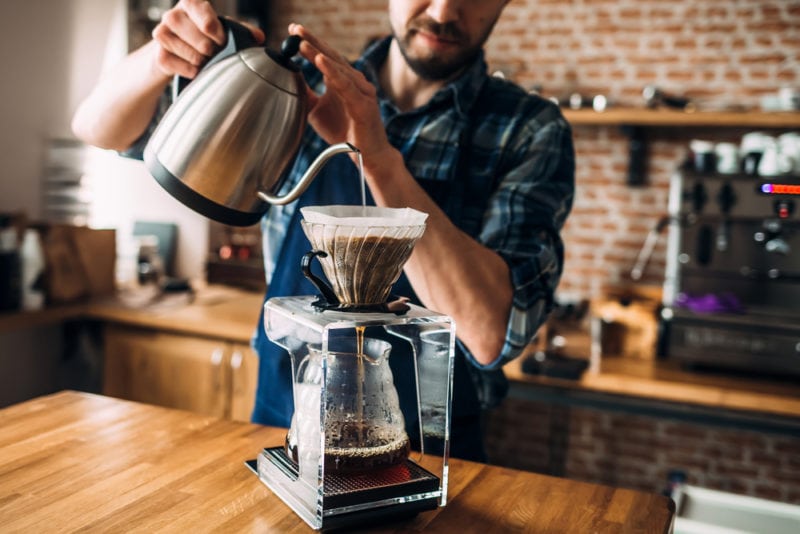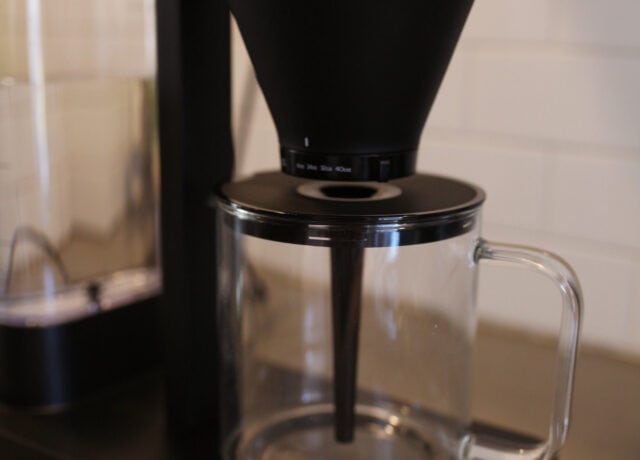Have you ever wondered where coffee came from? While many people consider Yemen the birthplace of coffee brews, the plant itself actually came from across the Bar al-Mandab Straight near the Red Sea and Gulf of Aden.
That’s right, coffee’s from Ethiopia, so we’ll be taking a look at what coffee is like from its source. Stick around for the full low-down on Ethiopian coffee.
At A Glance: Our Top 5 Picks for Ethiopian Coffee

Quick Summary: The Best Ethiopian Coffee
 | Our Top Pick METHODICAL COFFEE ETHIOPIA DUR FERES |
| Check Price → |
 | VOLCANICA ETHIOPIAN YIRGACHEFFE COFFEE |
| Check on Amazon → |
 | SPARROWS COFFEE ETHIOPIA DIMTU TERO |
| Check Price → |
| No products found. | WILD COFFEE SIDAMO COFFEE |
| Check on Amazon → |
| No products found. | FTO ETHIOPIAN YIRGACHEFFE COFFEE |
| Check on Amazon → |
 | OROMIA GOMMA MICROLOT ETHIOPIAN COFFEE |
| Check on Amazon → |
 | COFFEE BEAN DARK ETHIOPIAN YIRGACHEFFE |
| Check on Amazon → |
The Birthplace of Coffee
Once Upon a Time…
Coffee, like just about everything else, has an origin story. And it starts in Ethiopia with a man named Kaldi and his goats. It was 700AD, so Ethiopia was still known as Abyssinia.
Kaldi, as a goat farmer, was tending to his herd one day when he noticed that his goats were acting rather odd. Upon closer examination, he realized they were dancing! Now, goats can be rather energetic in their natural state, so you can only imagine what a sight this was to behold.
As he searched for the cause of his extraordinarily energized goats, Kaldi noted that they were eating red berries from a nearby plant. He concluded this strange, magical little fruit must be the culprit. So, he decided to bring a sample to a nearby monk.
Some say the monk was pleased with the discovery, as the magic fruit (coffee cherries) enabled him to stay up all night in vigilant prayer. Others finish the story by claiming the monk rebuked them and threw the fruit into the fire. Eventually, a delightful aroma arose, so they ground and boiled the beans to make a drink: the world’s first coffee.
The Facts
While the story of dancing goats and fire roasted coffee might seem a bit fantastical to you, the facts behind the tale remain true. Coffee plants did in fact originate in Ethiopia, and consequently spread to other regions, the first of which was Yemen in the 15th C.
As a result, many consider Yemen the birthplace of coffee as we know it. Because there is no proof of this tale, the earliest evidence of coffee drinking remains in Yemen. Nevertheless, Ethiopia still claims seniority when it comes to growing it.
Flavor Overview
For the most part, Ethiopian Coffees are full or heavy bodied with a variety of flavor notes ranging from brilliant acidity to winey or earthy notes. Overall, most people are drawn to Ethiopian coffees because they can range from pretty mild to some of the boldest brews you’ll come across. As a result, there’s likely something out there for any coffee preference.
Best Ethiopian Coffee
Methodical Coffee Ethiopia Dur Feres

Methodical Coffee Ethiopia Dur Feres
Berry bomb alert! This elegant natural process coffee has plenty of that berry sweetness we love, with an extra boost of peach and brown sugar that takes it over the top.
This bag of beans from coffee’s birthplace comes to you from Methodical Coffee, a South Carolina-based company with in-house roasting and three shop locations in Greenville. The beans for Dur Feres joe are sourced from communities where the highest-priced lots have been sold, meaning there’s a steady rotation of fresh and flavorful beans for each bag.
Each cup of this coffee has a sweet taste and aroma, thanks to notes of blueberries, blackberries, and cherries. The light roast is fruity, balanced, and refreshing, and it’s got a smooth mouthfeel we think you’re going to like.
Volcanica Ethiopian Yirgacheffe Coffee
We’re starting off with one of our favorite coffee brands: Volcanica. This 100% Yirgacheffe coffee is medium bodied with a bright acidity. The flavor profile is rough with fruity and winy notes. Additionally it has a thick body and earthy aroma with undertones of cinnamon and strawberry.
Because of the complex flavor profile, these beans are medium roasted to really showcase the complexity of the beans. Overall, it’s hearty and heavy and the cinnamon brings out a great intensity for this brew.
Sparrows Coffee Ethiopia Dimtu Tero

Sparrows Coffee Ethiopia Dimtu Tero
Soft and silky, and just oh-so-pleasant, this clean cup offers a classic Ethiopian floral profile with just a drop of lemon acidity.
This fruity Ethiopian coffee gives us all sorts of summertime vibes, but that doesn’t mean you can’t enjoy it during the other three seasons, too. Though it’s got notes of several summer staples — melon, Meyer lemon, and jasmine — we think you’ll love pouring this delicate joe into your favorite coffee mug no matter the time of year.
The company that brings us this refreshing and delicious roast and its sweet floral aromas, Sparrows Coffee, hails from Grand Rapids, Michigan, and sources these beans from Getachew Zeleke, founder of Dimtu Tero farm.
Wild Coffee Sidamo Coffee
No products found.
This Ethiopian Coffee from Wild Coffee is USDA certified organic, fair trade, and single origin. The small batch roasted 100% Arabica beans are sourced from small farmers and the company prides itself on transparency.This brew has rich a rich body with prominent fruit and berry notes. Also, there is a pleasant, wine-toned acidity.
FTO Ethiopian Yirgacheffe Coffee
No products found.
Next up is a USDA certified organic and Fair Trade coffee. Like the Volcanica option, this is also a Yirgacheffee Coffee. This one is a nice light-medium roast (also called a city roast), so you should be able to appreciate the full range of the flavor profile.
As for that profile you can expect notes of lime with a lemony-citrus finish and a hint of tangerine. Additionally, the body is mild and a bit on the dry side.
Oromia Gomma Microlot Ethiopian Coffee
This great option is from Cooper’s Cask Roaster and is perfect for those of you looking to try something outside of the mainstream Ethiopian Coffee options. Unlike most of the other options, it’s actually a light roast rather than a medium roast.
The lightness of the roast contributes to a sweet and tart acidity in addition to highlighting the complex flavor profile. You’ll detect floral notes alongside honey, lemon and fruit ones. All of this comes with a smooth, velvety body.
Coffee Bean Dark Ethiopian Yirgacheffe
Lastly, for those of you hoping to go the other way on the roast spectrum, check out this 100% arabica 5 lb bag of Yirgacheffe dark roasted coffee. It’s labelled as a French Roast but isn’t the excessively oily, almost burnt roast you’d usually expect from that label, though they are still pretty oily.The brew is robust, full-bodied and fragrant. You can look for a fruity aroma with cupping notes of lemon, chocolate, and blueberry.
Types of Ethiopian Coffee
Firstly, you should know that there are two main “types” of coffee grown in Ethiopia: garden and mountain. These divisions refer to the landscape on which the coffee is grown. Some people also divide Ethiopian Coffee into forest/shade-grown, semi-forest/shade-grown, garden grown, and plantation coffee.
Regardless of these designations, most Ethiopian Coffee farms were started by farmers who harvested wild beans and eventually transplanted beans to a more desirable area. The result is a coffee industry that is dominated by small farms.
Coffee Growing Regions
Most of the coffee in Ethiopia is grown the southern portion of the country. Here are some of the more popular sub-regions:
Yirgacheffe
Ethiopian Yirgacheffe coffee is the prime example of the small-farmer dynamic that is so prevalent in the country. Many of them are garden plots that span less than 5 acres, and they’re located in the Sidamo region (though there is other coffee that comes from that area) at altitudes of 5800 and 7600 feet.
Also, one of the things that makes this the most popular Ethiopian Coffee region is the prevalence of organic and fair trade practices. As for the flavor profile, you can expect a smooth, milder cup with a fruity acidity, rich body, and floral aroma.
Harrar
Moving off to the northeast from the of the Yirgacheffe at a slightly lower elevation, you’ll find the Harrar region. It’s still located in the Eastern highlands and, like Sidamo, is also one of the oldest growing regions. Harrar coffees are a distinctive wild-varieties, and are hand processed by locals.
Harrar coffee is flavorful and aromatic. It has less citrusy flavors and more of a natural mocha flavor. It has also been noted that beans from this region may have slight berry flavors with a strong, dry edge and medium to heavy body.
Limu
Moving on to the Limu region west of the capital, this centrally located area is known for it’s sharper flavor profile. These brews are winey with spiced and floral undertones.
Other Varieties
Some other regions you might come across when shopping for Ethiopian coffee are: Lekempti, Tepi, Kaffa, Djimma, Bebeka, Illubador, Wellega, and Gimbi. Like we said, as a general rule you can expect smooth, rich acidity and slight citrus notes with Ethiopian Arabica.
However, each region has some slight variations on that profile, creating a unique flavor.
Because of the rich flavors and individual features of the beans, there simply isn’t a category of “best Ethiopian coffee beans” on offer here. From the individual tastes of the consumer to the nature of roasting and brewing, this whole process is very personal.
How to Brew
Because Ethiopian coffees tend to be medium roasts or pretty close to it, they are rather versatile for brewing. So here are a few of our suggestions for the best brew methods for Ethiopian coffee.
Cold Brew
As we have mentioned, Ethiopian coffee is known for having bright, citrus-y flavors, which makes it perfect for a refreshing cold brew.
Also, because you can make a cold brew either drip or immersion style, you can control how intense or crisp the body is. Just make sure to use a pretty coarse grind either way to avoid over extraction.
Additionally, Cold Brew is a great choice if you are trying to avoid a bit of the acidity of these beans.
Automatic Drip
If you prefer to go for something hot, your regular drip brewer will also do the trick for making Ethiopian coffee. However, with this method it is even more important that your fresh in both roast and grind.
As a drip method with a paper filter, this method is best suited for people who prefer to keep things light in the body so that you can appreciate the complexity of flavors.
Pour Over
Lastly, the go to method for most people when brewing coffee with this origin. Like with a drip brewer, there is a paper filter which helps to enhance the clarity of the brew.
Also, Pour Over coffee allows you the greatest control to get the ultimate brew.
In Ethiopia…
Coffee Production
Firstly, to understand the significance of coffee in Ethiopian, you’ll need to know just. how much coffee they’re producing. They are the 5th highest coffee producing nation globally, and they export about 3.5 million bags of coffee.
However, that’s only a fraction of the amount they produce. Unlike many other high ranking coffee producers, Ethiopian keeps about half of the total 6.5 million bags that they produce for domestic use.
Despite being less than half its size, Ethiopia produces about 100,000,000 lbs more coffee than India (7th largest coffee producer). And it produces more than half the amount of Indonesia (4th largest coffee producer), which is also about double its size. Additionally, Ethiopia easily claims the top coffee production spot among African countries.
Coffee Culture
Hopefully now that you at least have a foggy idea of how huge coffee is in Ethiopia, it shouldn’t surprise you that there’s a whole ceremony associated with it.
The Ethiopian Coffee ceremony is an important part of the social culture as it takes up a significant amount of community and individual time. Being invited to one is considered to be a sign of friendship or respect.
The ceremony is typically conducted by a young woman and can last two to three hours. Incense burns as she roasts coffee beans in a flat pan until pungent. They’re then ground using a mortar and pestle. After the preparer thoroughly grinds the coffee, they stir it in a black clay pot called a jebena.
Once brewed, the brewer strains the coffee multiple times before the youngest child announces that it is serving time. Small china cups are distributed and the young girl begins pouring out servings from about a foot above the cups (a method that requires a great deal of practice). The eldest family member or guest receives their serving first, followed by the remaining company.
Coffee may be served with a bit of sugar or salt, but no milk. After everyone has been served more water is added and everyone is served at least another two rounds. As elaborate as it sounds, this coffee ceremony is often performed 2-3 times a day.
Impact of Climate Change
As with many countries where coffee is a primary economic force, the shifts in climate have caused some serious issues in Ethiopia. Because the industry is dominated by small-time farmers with equally small plots, disruptions in rain patterns can cause serious damage.
The wet-dry cycle heavily influences coffee plant, so abnormal rain that far exceeds or undercuts usual patterns can cause unsuccessful or even failed harvests. The result is that many farmers have been forced to abandon their coffee crop and opt for a new one, which often contributes to deforestation.
While coffee is better when shade-grown, the opposite tends to be true for other crips. So while it may be ideal for farmers to leave forest canopies undisturbed when growing coffee, they must remove these covers when switch to a new crop.
Wrapping Up
There you have it! Everything from the origin of coffee to current coffee culture in Ethiopia and even a few of our team’s favorites. We hope you get a chance to try one of the coffees we’ve recommended here.
Happy Caffeinating!










